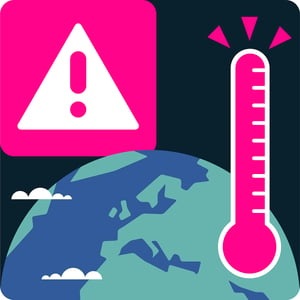How to Have a Conversation with Donald Trump or Any Other Climate Change Sceptic
Trump’s “drill baby, drill” stance has raised alarms, especially as US oil production has risen by 70% since 2016. His push against environmental protections is fueling climate change scepticism and reinforcing the beliefs of those who don’t see the urgency of the crisis. So, what can we do about it?
Convincing a Climate Skeptic
Imagine this. You’re trapped in a lift with Donald Trump. It’s broken and you have a few minutes until the Secret Service rescues him. Perhaps you should use this precious time to try and change the mind of the world’s most powerful climate change denier?
It’s your big chance. Yet, however strongly you believe in the need for greater action to halt the climate emergency, could you provide the facts and arguments to convincingly and briefly contend your case?
Wasted energy makes up 30% of the average energy bill - do something about it! Get more from your smart meter with Loop.
While you may never get a broken lift audience with Trump - or any other die-hard climate denier - you may encounter friends, family, or the occasional taxi driver who just aren’t that convinced about the need to change.
Here are some basics to answer any myths and arguments chucked your way, without resorting to preaching, yelling or tearing your hair out.
The Sceptic Says: Not All Scientists Agree That Climate Change Is Man-Made
This argument is, technically, correct. Just 97% of climate scientists agree that climate-warming trends over the past century are extremely likely down to people.
That leaves 3%. However, researchers tried to replicate the results of those 3% of papers and found that “every single one… had an error—in their assumptions, methodology, or analysis—that, when corrected, brought their results into line with the scientific consensus”.
The Sceptic Says: Where’s the Evidence That Climate Change Is Real?
Here are a few of the main ways that scientists have shown climate change to be real:
- They have photos showing glaciers are melting and retreating in the Alps, Himalayas, Andes and beyond.
- Ice cores provide evidence of a rapid increase in temperature. Annual ice accumulation can be counted, like rings in a tree. The ice can reveal the temperature of each year going back hundreds of thousands of years.
- They use thermometers: the planet's average surface temperature has risen about 1.1 degrees Celsius since the late 19th century.
- The Greenland and Antarctic ice sheets have got smaller. Data from NASA shows that Antarctica is losing 150 billion tonnes of ice per year and Greenland is losing around 240 billion tonnes yearly, adding to sea level rise.

Global sea levels rose about 8 inches in the last century. Again, there has been an acceleration in this trend: the rate in the last two decades is nearly double that of the last century.
The Sceptic Says: Global Warming Can’t Be Real as It’s Freezing Cold Outside
“What the hell is going on with Global Warming [sic]? Please come back fast, we need you!”
That was part of a tweet from Donald Trump during a freezing cold January in 2019. The argument here is that climate change can’t be real if it’s not warm outside.
It’s important to remember that Trump was talking about the cold ‘weather’; there is after all a difference between climate and weather - climate is the average weather patterns in a region over a long period.
Climate scientists believe Earth will experience more extreme, longer-lasting weather events as the planet warms. Between wildfires and floods, we have already an increase in drastic weather events since Trump’s last presidential run.
The Sceptic Says: What’s Wrong With a Little Warming?
A lot. So far, the impacts of climate change include:
- Ocean acidification as oceans absorb carbon dioxide and become more acidic; this, along with higher temperatures, damages marine ecosystems.
- Extreme weather events, such as heatwaves, droughts, and floods.
- Food insecurity as the effects of global warming - including flooding due to rising sea levels - cause damage to farmland. This, among other problems, can cause people to fight over resources or to migrate.
The Sceptic Says: Climate Change Is Natural
The Earth indeed does, over the millennia, go through cycles of colder ice ages and then warmer periods, caused by changes in Earth's orbit around the sun. In addition, things like volcanic eruptions can influence the climate.
But now these changes are happening too fast to be explained by natural cycles. Since the Industrial Revolution, the high levels of greenhouse gases in the atmosphere - including a 40% increase in carbon dioxide during the 20th and 21st centuries - have seen the global temperature rise at a much faster rate.
In other words, human activity is the main cause of global warming.

The Sceptic Says: What Difference Can One Person Make Anyway?
Perhaps not an argument you would hear from the leader of the world’s largest economy. But even the most green-minded of people may sometimes wonder whether they, as an individual, can make the slightest bit of difference.
The reality is, climate change isn’t just the responsibility of big corporations or governments. Individuals play a significant role too. Did you know, burning fossil fuels for electricity and heating accounts for 34% of human-made greenhouse gas emissions?
By making small, intentional changes—like reducing your energy use with tools like Loop, or even making bold choices like giving up flying—you can inspire others and help shift what’s considered 'normal.' Every action counts.
• • •
Cut Your Energy Bill With Loop
Loop is a FREE energy-saving app that links to your smart meter, analyses your energy use and shows you easy ways to save. On average, Loop users cut their energy use by 15%! How much could you save?



.jpg)




